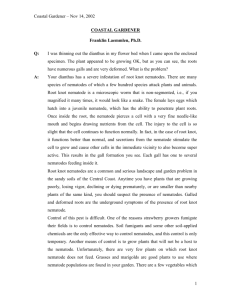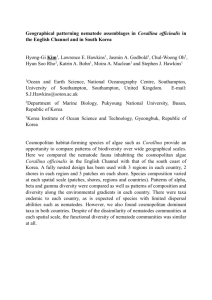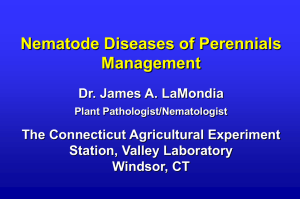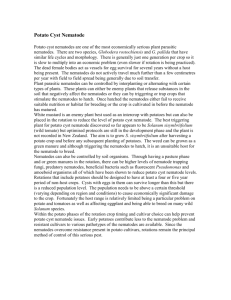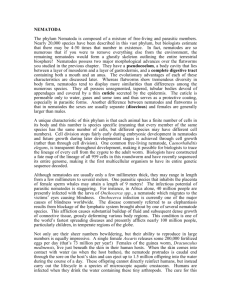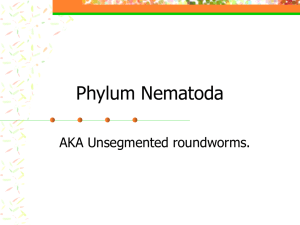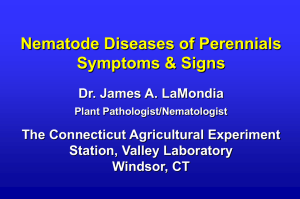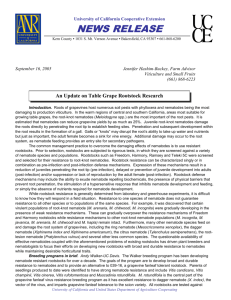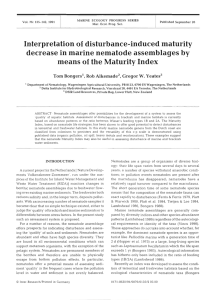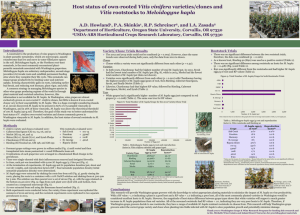Minutes
advertisement
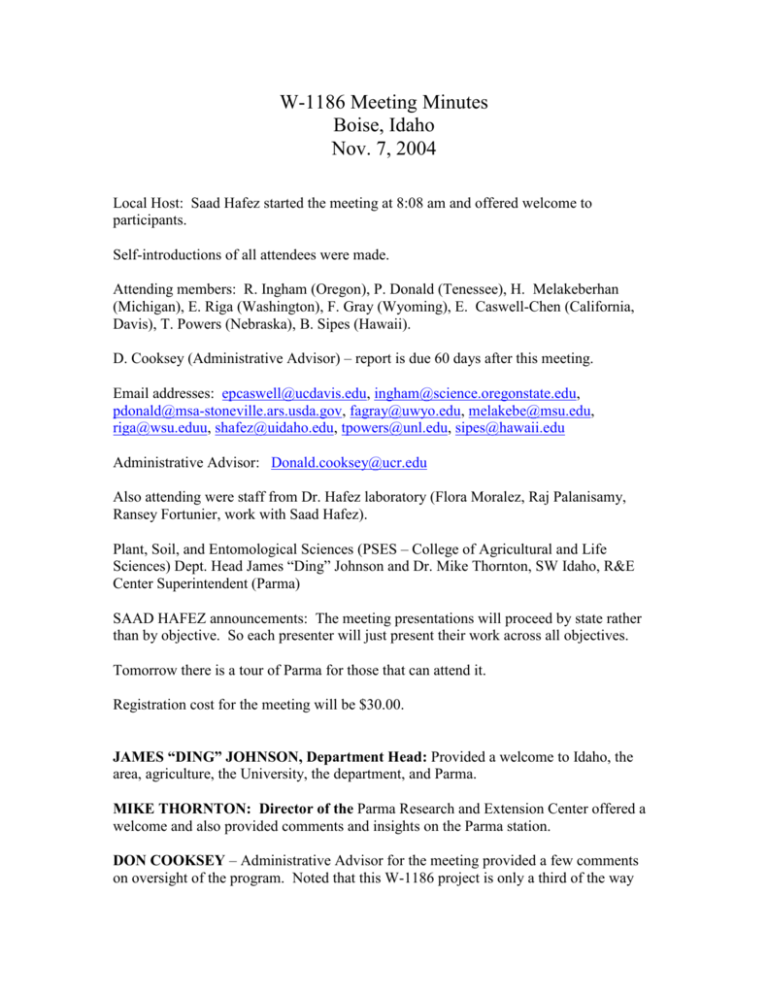
W-1186 Meeting Minutes Boise, Idaho Nov. 7, 2004 Local Host: Saad Hafez started the meeting at 8:08 am and offered welcome to participants. Self-introductions of all attendees were made. Attending members: R. Ingham (Oregon), P. Donald (Tenessee), H. Melakeberhan (Michigan), E. Riga (Washington), F. Gray (Wyoming), E. Caswell-Chen (California, Davis), T. Powers (Nebraska), B. Sipes (Hawaii). D. Cooksey (Administrative Advisor) – report is due 60 days after this meeting. Email addresses: epcaswell@ucdavis.edu, ingham@science.oregonstate.edu, pdonald@msa-stoneville.ars.usda.gov, fagray@uwyo.edu, melakebe@msu.edu, riga@wsu.eduu, shafez@uidaho.edu, tpowers@unl.edu, sipes@hawaii.edu Administrative Advisor: Donald.cooksey@ucr.edu Also attending were staff from Dr. Hafez laboratory (Flora Moralez, Raj Palanisamy, Ransey Fortunier, work with Saad Hafez). Plant, Soil, and Entomological Sciences (PSES – College of Agricultural and Life Sciences) Dept. Head James “Ding” Johnson and Dr. Mike Thornton, SW Idaho, R&E Center Superintendent (Parma) SAAD HAFEZ announcements: The meeting presentations will proceed by state rather than by objective. So each presenter will just present their work across all objectives. Tomorrow there is a tour of Parma for those that can attend it. Registration cost for the meeting will be $30.00. JAMES “DING” JOHNSON, Department Head: Provided a welcome to Idaho, the area, agriculture, the University, the department, and Parma. MIKE THORNTON: Director of the Parma Research and Extension Center offered a welcome and also provided comments and insights on the Parma station. DON COOKSEY – Administrative Advisor for the meeting provided a few comments on oversight of the program. Noted that this W-1186 project is only a third of the way into the current 5-year life of the project. Started in Oct. 2003 is the current cycle with expiration on Sept. 30, 2008. Accordingly, Jan 15, 2008 is the deadline for the completed project renewal. So, the group should start planning on renewal just in case a revision of the renewal request is required. That means the group will want to have a draft of the project renewal the November of 2006 meeting. That way, the revised draft can be discussed in Nov 2007 and ready to submit by Jan. 15, 2008. He also discussed funding that is available. Fed budget for multistate projects (HATCH) funding – States are required to spend 25% of funding on multistate projects. Final budget is not in yet, but it looks relatively solid and possibly up very slightly from 2004. CSREES funding is probably about the same as last year. The NRI grants program will be increased by ca. $20 million from last year (idea is to get it up to $200 million support). Was $164 million last year, and is up to $180 million or so for this year (not finally approved yet). Note: There are three nematode programs in the NRI, with different dates. 1. Integrative biology of arthropods and nematodes was Nov. 2, 2005 2. Arthropod and nematode gateways to genomics is Feb 1, 2005. 3. Functional genomics of arthropods and nematodes June 15, 2005 Mary Purcell (mpurcell@csrees.usda.gov) is the contact person for the NRI, and she will be a workshop speaker at the SON meeting next year. A mail server has been set up to notify subscribers when NRI publications such as RFAs or Abstracts of Funded research are available electronically on the WWW. Subscribers will not receive the document itself, but instead will receive an email containing an announcement regarding the document’s availability on the Web. To subscribe: send an email message to: Nri-epubs@lyris.csrees.usda.gov In the body of the message, include only the word: subscribe Please note that there is another Grant opportunity that is available: 4. Microbial sequencing project – includes nematodes and agriculturally important organisms. Idea is to get genome sequence information. For high throughput sequencing information of nematodes and other microbes. Early Feb. 2005 deadline(?). Joint NSF ($10 million) and USDA ($5 million) ($15 million and will fund projects up to $2 million) funding is where this comes from. Anne Lichens-Park is the USDA contact person for this, and will discuss proposals and let you know if it is feasible. Research on invasive pests and exotics is available through the Univ. of California IPM program. Please see the following www site for more information. www.ipm.ucdavis.edu/exotic/ The web site will lead you to the Exotic / Invasive research support. At 9:47 am the introductory and administrative comments were completed. Saad Hafez: Thank you for the administrative reports that have been presented thus far. The group moved on to state reports from the members, with each speaker to have about 30 minutes to present. We will go alphabetically through the member states that are represented and have presentations summarizing research efforts. Individual reports are submitted for more details on research progress than what is recorded here. California, Davis: Ed Caswell-Chen presented progress on research on aging in C. elegans wild-type and mutant strains, and the activity of the potential nematode biological control agent Lysobacter enzymogenes strain C3 against a range of plantparasitic nematodes. Idaho: Saad Hafez presented his report on his research. Has done work on screening of alfalfa varieties for Pratylenchus penetrans control. Also screening alfalfa varities and bean lines with resistance to Meloidogyne chitwoodi (and beans to M. hapla). Also screening sugar beet genotypes for resistance (tolerant) in H. schachtii and found a wild-type beet with tolerance. Described a survey that included assessment for potatocyst nematode (and potato wart and mop top virus), and other cyst nematodes and burrowing nematode (all negative), and M. hapla (0.3%) and M. chitwoodi (3.0%) in Idaho’s major potato-producing regions. Described assessment of in vitro toxicity of green manure crops on M. chitwoodi egg hatch (alginate gel with eggs of M. chitwoodi in them are placed near root (Rodriguez-Kabana technique) or exposed to root extracts – rapeseed “Humus’ mustard ‘Metex,’ and oilradish ‘Adagio’ and ‘Colonel’). Plant green manure and grow for 8 weeks or so in the fall (plant at end of August) in Idaho (oilseed radish does better in the cold). Michigan: Haddish Melakbeheran reports on work at MSU. A project that they are initiating on genetic variability and environmental and nematode population challenges to developing sustainable management options. The research being planned will address the degree to which different nematode isolates and nematode community structure will vary in response to environmental factors (e.g., pH, soil type, soil chemistry, nutrient contents…) in different management systems as they are changed or moved toward “sustainable” systems. Preliminary data for field site comparisons described. Nebraska: Tom Powers reported on research from University of Nebraska on the status of 18S bar code project for identification of nematodes. Been using the 3’ region of 18S as a DNA barcode for identification of nematodes relative to identification relative to morphospecies. The basic idea is that it is possible to type species by a small section of DNA. Do barcodes correspond to morphospecies (tough to get barcode OTUs to match up with the morphospecies in some cases)? Powers Lab is sampling Konza Prairie in Kansas and have examined 8,400 specimens thus far. Males are rare (esp in Dorylaimids). Need many more isolates in GenBank to understand what the variation is. See the web site for more information: http://nematode.unl.edu Oregon State University: Russ Ingham discusses research at OSU dealing with management of M. chitwoodi with green manure cover crops and crop rotation sequences. Remember that problems occur at low densities. A range of cropping sequences were monitored over a number of years (2001, 2002, 2003, and 2004). Wheat-corn-cornpotatoes is a standard rotation. Used clover as a control treatment as a nonsuppressive nonhost instead of fallow (because fallow with irrigation is not the same as a dry fallow). Note trying to be realistic relative to what growers might be willing to pursue in order to overcome grower reluctance to adopting new approaches. The basic studies revolve around rotations with mustard blends as cover crops at the end of the year of wheat (for example) (thus the cover (such as mustard or radish) goes in at the end of the growing season and at the end of the cropping sequence end that is, plant cover in late August and leave in until October and then bare fallow from late October until April the next spring – mustard usually produces the most biomass). Other plant-parasitic nematodes were present but the data for those was not presented here today. Tenessee: Pat Donald discusses ARS USDA research at Jackson, TN. Pat stated that 50% of her job is to screen varieties of soybeans for Soybean Cyst Nematode, and she has done research on this (220 soybean varieties with Race 3 HG type 0) (see progress report). Has seven different races of soybean cyst nematode, and has been able to better characterize these with the HG designations. Did research to determine the variation in the greenhouse “populations” or cultures that she was working with. Compares the reproduction on the test lines with reproduction on Lee 74 and calculate a female (cyst) index comparison between the two. Doing replications in time is preferred for assessing the reproduction on the test varieties. Dr. Donald also described research on nematode population densities relative to cropping sequence (away from soybeans). Washington: Ekaterini Riga reported from WSU on research from potatoes, grapes, and treefruits. Has done work on arugala as a cover crop, given that they are running short of nematicides in Washington (M. chitwoodi and P. allius are both problems that are recognized by growers). Discussed primarily M. chitwoodi work. There is a general interest in lowering fumigant costs, but some alternatives are expensive and might not want to implement those. Research on cover crops that is underway was described, including arugala (‘Nemat’) (works as a trap crop luring the RKN into roots but not supporting reproduction although swollen females were seen) and mustards, and cover crop mixes. Wyoming: Fred Gray discussed research from Wyoming. Research on RKN resistance in Sainfoin (a legume forage crop, that livestock is very fond of) was presented. The research had a long history, starting in 1981 but through to release of a tolerant variety. Sainfoin is very susceptible to M. hapla, with lots of reproduction – unable to find resistance in Sainfoin, but a M. hapla tolerant Sainfoin variety ‘Shoshone’ is due for release. Hawaii: Brent Sipes discussed research work on Taro (a culturally significant root crop for Polynesians). Roots have oxalic acid crystals in them, so you need to cook them to eat them. It can be grown dryland (and RKN (M. javanica) is a severe problem infecting the corm, but no galling no clubbing is seen) and wetland conditions. Research was conducted on controlling RKN in Taro – looking for resistance in collections of Taro. There was no absolute resistance to the RKN, but there was a range of tolerance to the nematode. Research in Hawaii is also assessing nematode management efficacy of mustards, sorghum/sudangrass hybrids, Tagetes, sunn hemp, black-eyed Susans, and other green-manure cover crop possibilities. Group Business: New Chair: Will be Pat Donald New Vice Chair: Will be Brent Sipes New Secretary: Ekaterini Riga Location for the next meeting will be: Davis, California Dates for the next meeting will be: After NRI and the MeBr meetings (so, the second week of Nov.). Ed Caswell-Chen will make arrangements for the meeting and will notify the membership of the group. The meeting will resume tomorrow for the tour of Parma and discussion of research there. Meeting adjourned for today. Nov. 8, 2005 Participants visited the Parma research station and had the opportunity to see Dr. Hafez’ research program and facilities. Also had an opportunity to tour local agricultural production. Minutes recorded by E. Caswell-Chen
